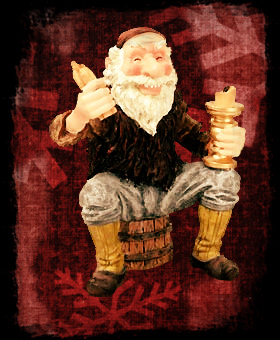
Last but not least! Kertasníkir (Candle Beggar) arrives just in time for Christmas celebrations, on December 24. Be careful: this Lad is perhaps one of the wickedest of the gang.
The thirteenth was Candle Beggar
– ’twas cold, I believe,
if he was not the last
of the lot on Christmas Eve.
He trailed after the little ones
who, like happy sprites,
ran about the farm with
their fine tallow lights.
What Kertasníkir does is stealing candles. He does it not only because he finds their glow attractive, but also because in the past candles were obtained from animal fat thus they were very appetizing. Maybe Kertasníkir doesn’t eat candles anymore, but he still likes to steal them when he comes to town.
This may appear like a frivolous kind of prank to our contemporary civilized ways, but in the old days candles were in many cases the only source of lighting available. In Iceland, especially in the darkest days of the cold season, darkness was a danger and an enemy that one couldn’t underestimate. A candle could indeed make a difference in more than a few cases. Also, let’s not forget darkness is one of the classic fears of humans by instinct. Being deprived of light has always been for human beings quite a serious matter.
And now… That’s all, folks! We had a good time talking about the Yule Lads, these unrepentant rascals! I am disappointed that they forgot to leave anything for us during these thirteen days. I was honestly looking forward to receive a good amount of potatoes, the present they , since I’ve been so bad in the course of year 2010 — I was hoping I could be given enough potatoes to mash or fry them for Christmas, that is. Maybe it wasn’t enough. Next year I’ll do my worst, I promise.
Thank you for your lively account of the twelve Yule Lads. What did the little trolls leave for the naughty children before potatoes were introduced from the Americas? Or did Lief Ericson bring them back from Vinland?
Twelve? Sorry, thirteen!
Before 1746, when finally law prohibited using them to scare Children, the Yule lads were not lovable enough to leave presents of any kind. They were, like their mother Grýla and the Yule Cat, terrible creatures that children had to fear. In recent times only they mellowed and started leaving presents (which includes potatoes to naughty children ).
On a partly unrelated side note, I can say in Italy we have, apart from Santa Claus (the international standard) a local folklore figure that is still popular today. She is called “Befana” and she leaves presents or coal, according to merits, to children on the 6 th night of January.